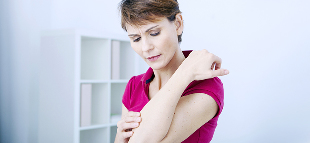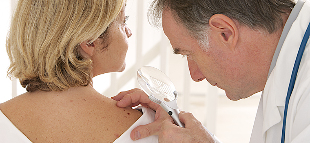Psoriasis is not infectious it is a chronic disease, in the majority of cases it affects the skin (at least – to the nail plate, and scalp). It manifests itself excessively dry, red spots, protruding slightly above the surface of the skin (papules). The merger, papules form platelets, which are the sources of chronic inflammation.

Psoriasis is the past or no?
Responding to the question, is it contagious psoriasis or not, you must understand that the disease is not transmitted nor the sex, nor the air, nor of touch, nor in any other way. Are infected you cannot.
In case of violation of the process of exfoliation keratinized scales on the body appear dry spots. Die from them is not possible, but the ill experience serious psychological distress because of its appearance.
The causes of psoriasis
So far they are exactly what occurs in psoriasis. There are several theories of the development of the disease. The experts are inclined to believe that the defeat of the skin and nails can cause:
- stress, emotional experiences, negative;
- endocrine pathology;
- hereditary predisposition;
- a malfunction of the immune system, which are violated in the processes of growth and division of epithelial cells.
Autoimmune cause of psoriasis is that the immune cells of cells T-helper and T-killer, it is normal responsible for the defense of the organism against tumor cells, viruses and pathogenic bacteria, they begin to penetrate in the upper layers of the skin. Here we produce substances that activate the inflammatory process. As a result, the skin cells begin to strenuously to divide and multiply. You look at the proliferation.
The development of psoriasis as possible, and with a total of the action of different factors the following list:
- Very thin and just moisturized the skin (sebum is product little).
- Frequent contact with irritating compositions – low-quality makeup, alcohol solutions for the cleaning of the house.
- Too often this body wash, hands (especially if you use a hard sponge and antibacterial soap/shower gel).
- The abuse of alcoholic beverages.
- The development of infectious diseases caused by staphylococcus aureus, streptococcus, fungi.
- The intake of antidepressant medications, lithium carbonate, beta-blockers, anti-malarial and anticonvulsant drugs.
- Change of climate zone.
- Mechanical injury to the skin.
- The tendency to allergic reactions.
- HIV infection.
Classification of the disease
If you explore various pictures of psoriasis in the initial phase, will be obvious differences – there are different varieties of this disease dermatological. According to the place of defeat is:
- Psoriasis of the scalp (which manifests itself with itching and bleeding of the skin).
- Psoriasis of the nails (the nail plate gradually separates from the nail bed and become painful, this form red spots).
- Hand foot psoriasis (disease spread only on the feet and/or hands).
- Skin psoriasis (dry plaques that appear on different areas of the body).
- Arthropathy in psoriasis (amazed at the joints).
- Sexual psoriasis (disease that covers the skin of the genitals).
Clinical forms of psoriasis:
- The common, or vulgar. It is manifested flat rose-red papules of small size, which rise slightly above the healthy skin. From the top papules covered with light scales, which begin to fall out, even with a light touch. If psoriasis treatment is started late, small outbreaks are united with those of large dimensions.
- Exudative. It is more common in people with obesity, hypofunction of the thyroid gland, diabetics. The symptoms of psoriasis this form are the following: the papules are of a bright red colour, from the top on them appear yellow-gray scales. The plates are amazing, the folds of the skin cavity in the axillary area, the area under the breasts of women. The patients complain of itching, burning sensation.
- Seborrheic. Psoriasis observed on the head, bte, nasolabial folds, between the shoulder blades, on the chest. Border spots are not clearly expressed. Flaking silver-yellow. If you look at the pictures of psoriasis in head, you will experience association with the common fungal disease, such as dandruff.
- Hand foot. The disease is common in people between the ages of 30 and 50 years, whose work is tied to a heavy physical work. In this form, may occur and rashes on the body.
- Psoriasis pustular. On the body form pustular elements. In medicine show a type of pustular forms – psoriasis Tsumbush. It is idiopathic (primary) - on the skin appear bubbles, which turn into pustules. The pustules are geolocated and dry. Later appear typical for the disease of desquamation of the precipitation. And also the secondary with benigni in the course of. In this case, the abscesses occur on the surface of typical psoriatic platelets due to irritation of drugs.
- Another type of pustular forms – psoriasis Barbera. Affects only the soles and the palm of the hand. On the skin appear purulent pustules. They are not geo-referenced, with the passage of time are transformed into a higher level of dry crust. Psoriasis Barbera characterizes the symmetry of defeat.
- Arthropathy (joint). A severe form. Common in patients who have skin rashes. It usually occurs after five to six years after the appearance of the first symptoms of the disease, if the treatment of psoriasis was illiterate. Joint pathology of the system can be different, starting from the non-expressed arthralgia, does not lead to changes in the articular machine, finishing warp ankylosis (joint becomes completely immobile).
- Psoriatic eritrodermia. This is the result of a vulgar or exudative psoriasis. Affecting almost the entire skin. Becomes red, sprinkled a lot of dried flakes. Increases the body's temperature, we observe an increase of lymph nodes (especially the femoral and inguinal). If the patient does not recognize, how to treat the psoriasis, perhaps the loss of hair, fragility of nails.
According to the policy, seasonal effects psoriasis are divided into:
- years;
- winter (most common);
- indefinitely.
The symptoms of psoriasis
From the dominant of the symptoms of psoriasis treatment depends, then, on first convocation, the doctor conducts a thorough examination of the patient, we study the localization of psoriatic outbreaks.
The disease often manifests itself in the winter. In the summer, under the influence of solar radiation, signs of psoriasis can disappear completely. However, when the "summer" form of the disease exposure to the sun, on the contrary, you need to avoid. In a period of acute the patient complains of very severe itching. The defeat of the nail plate was observed only in 25% of patients.
When the disease of the scalp the hairs are not involved in the pathological process. Before starts to peel off the skin. With time the area rashes may "exchange" on the area of the neck, behind the ears. The inflammatory process is determined very fast by division of keratinocytes.
In psoriasis, the palms and stop the stratum corneum thickens and is covered by deep cracks. Photo of psoriasis in the initial phase proves blisters with clear content. Later they turn white and become dark and scars.
With regard to the nail plate, the most common are two types of damage:
- The nail is covered by holes that appear similar to signs (type"thimble").
- The nail changes color and starts to flake off, which is reminiscent of the disease fungal. Through the nail plate varies in psoriatic papule, surrounded red rimmed.
Phase of psoriasis
Despite the fact that it is still a debate on what is psoriasis and what may cause its appearance, the stage of disease that is already well studied. Three of them:
- Progressive (initial). On the surface of the skin appear neoplasms such as a rash, with an upward trend to the suburbs. They are distributed on a healthy skin and form an oval or rounded and the platelets. The spots have a pink or red. Scaly crust on them, still not there – only whitish scales. Edge of the mouth a little compressed. Consequently, the combing new eruptions.
- Fixed. Get through one to four weeks after the first symptoms of psoriasis. The platelets become more clear. New rashes do not appear old – slowly dissolves. Note the healing papules in the direction from the center to the outside, for which their shape becomes annular. The entire surface healing outbreaks is covered with white scales.
- Regressive (damped). Color psoriatic platelets is virtually indistinguishable from a healthy skin. Minimising the itching. Around the foci, you form a "collar Voronov", which is a ring of dense layers of dead skin. If the patient uses a quality of ointment from psoriasis, a phase of retreat lasts about a month. In the contrary case, the process of "damping" can take up to six months.
The task of a patient diagnosed with psoriasis – all the time to keep the disease in remission.
In the presence of similar symptoms, consult a doctor immediately. It is easier to prevent disease, cope with the consequences.
How is the diagnosis of psoriasis

Diagnosis of psoriasis is responsible dermatologist. The procedure is based on the external inspection, assessment of the state of the skin and nails, the study of the localization of the outbreaks. There are more analysis with obvious symptoms and are not assigned. If you are experiencing difficulty with the staging of the diagnosis, the taking of a sample of inflamed skin (biopsy), who study under laboratory conditions.
With the complaints of pain in the joints takes place x-ray. It is also a blood test to verify the absence of other forms of arthritis. To exclude a fungal infection is the test with the use of potassium hydroxide.
How to cure psoriasis
The treatment of psoriasis is complex. Includes:
- total therapy;
- therapy local;
- physiotherapy.
Before you determine to cure psoriasis, the dermatologist determines the stage of the disease, its clinical form, the prevalence of the process. With the appointment of drugs into account the age of the patient and the presence of comorbidities. Are usually selected the most safe for health drugs that are characterized by a minimum number of side effects. If you do not provide transition of the psoriasis in a phase of regression, the correct treatment.
The medicines for psoriasis
The medication, taken by mouth, help medium and heavy phases of psoriasis. These include:
- Vitamin A derivatives (retinoids). To reduce the speed of maturation of keratinocytes. Normalize the differentiation and maturation of cells.
- Immunosuppressants. Reduce the activity of T lymphocytes, causing reinforced the division of the cells of the epidermis.
- Drugs for the treatment of malignant tumors. Inhibit the reproduction and growth of atypical cells of the skin.
Physical therapy for psoriasis
Physiotherapy will greatly improve the health of patients suffering from psoriasis. In some cases, this allows to completely abandon the drugs. The most commonly used:
- Phototherapy selective. The affected skin radiate UV rays with a wavelength of 280-320 nm. Is assigned 15 to 35 procedures.
- Photochemotherapy (PUVA-therapy). The method includes the sharing of a photosensitizer inside and long-wave UV exposure externally. The ultraviolet rays penetrate deep into the skin, and the photosensitizer blocks the process of DNA synthesis of the cells of the skin, reduces the speed of their division. Length of course – 20 to 30 treatments.
- The therapy laser. Using a laser with a wavelength. The laser provides accelerated the resorption of the plates, eliminates the formation in their place the scars.
- The use of monochromatic ultraviolet radiation. Each fireplace alternatively deal with valve/source UV laser. Healthy skin not interested. The optimal method, if it had been hit less than 10% of the skin. Duration of treatment – from 15 to 30 sessions.
- Electrophoresis. It turns out effects mild electrical impulses to the brain for 20-60 minutes. As a result, the patient is calm, the normal functioning of the central nervous system, causing psoriatic plaques, while they start to suck up all.
- ULTRASOUND-a therapy. Is decongestants, anti-itching and analgesic. Accelerates the resorption of scars. If necessary, be combined with phonophoresis. To obtain a therapeutic effect, it is necessary to the performance from 7 to 14 sessions.
- The magnetic therapy. Has a general revitalizing effect on the body. Reduces inflammation, reduces itching and burning sensation, helps to get rid of joint pain.
- Treatment of bee venom. With the help of a device for electrophoresis or ultrasound in the body injected with the poison. It is characterized by resolving and anti-inflammatory effect, normalizes metabolic processes.
- The hyperthermia. Affected by psoriasis tissue heated pads to heat the mixture to a temperature of 40 degrees. The treatment helps to improve the functioning of the immune system, reduce the impact of the disease on the skin.
The diet in psoriasis
Resolved the products of exacerbation of psoriasis are:
- fruit (apples, apricots, peaches);
- fruit juices;
- vegetables (beets, potatoes, radishes, watermelon, pumpkin);
- green;
- fruits (all except red);
- lean meats (beef, veal, eat sausages, meat of a rabbit) – up to 200 grams per day;
- any nuts;
- low-fat fish;
- dairy products, cottage cheese and cheese;
- whole wheat bread;
- algae.

Patients suffering from psoriasis there are:
- smoked dishes;
- the red fish;
- the animal fats;
- the eggs;
- pork and duck;
- muffins.
And ' forbidden to drink coffee, soft drinks and alcoholic beverages. It is advisable to limit the consumption of sugar. To cleanse the body twice a week you should spend the days of fasting vegetables, apples or kefir.























